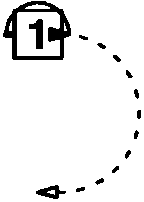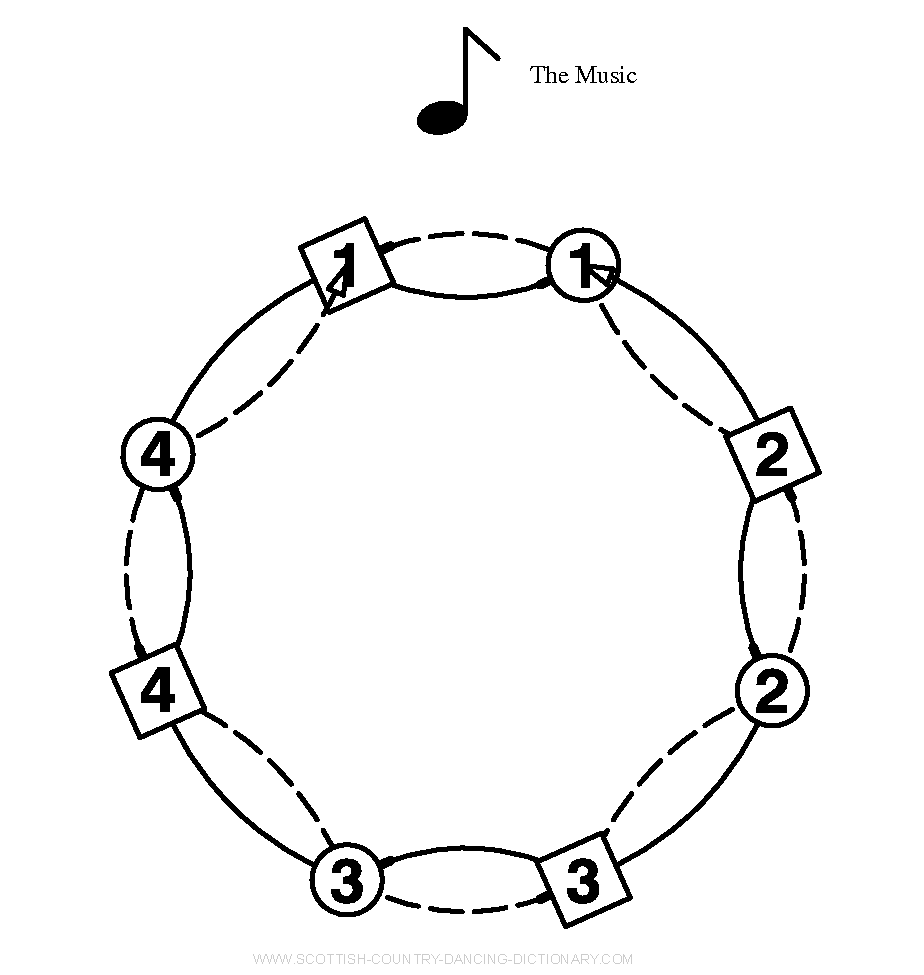Figures
The term, Figure, in Scottish Country Dancing covers all those choreographed movements from which the complete Repeat of a dance is made up. This section defines the simpler movements, many of which are also the building blocks from which the more Complex figures are constructed. Allocation to these basic Figures or to Complex figures is somewhat arbitrary. The objective here has been to include in this section all those Figures which the Beginner needs to master because they will appear in most Class or Ball programmes; Complex figures cover those forms which appear more rarely and which require a greater degree of experience and application.Traditional RSCDS publications used the terms Progressions for those Figures, such as 1st couple Cast While 2nd couple Step up or Allemande, which interchange the Places of two Couples in a Longwise set, and Formations for those, such as Reels of three on the sides or Promenade round, which do not. In more recent times, the RSCDS has chosen to use Formations to cover both but Figures is shorter and more widely used.
The individual Figures in this section are organized alphabetically under the following main headings, for which links are provided at the foot of this page.
Arches
Figures in which one or more Dancers Dance under an Arch made by the joined hands of two others.
Casting
Figures which involve Dancing Out of the Side of The set.
Chains
Figures in which half the Dancers proceed clockwise around The set and the others anticlockwise, each Taking hands alternately By the right and By the left with the approaching Dancers. Rights and lefts is included here since it is logically a Chain. Linear Figures which have a Turn at the Ends of the Chain movement, such as Ladies' chain, are included under this heading.
Chasing
Follow-my-Leader Figures.
Crossing
Figures in which the Dancers Dance Across The set or on intersecting paths or Exchange positions.
Figure of eight
Figures in which a single Dancer follows a path which from above looks like an "8" and is often Danced around two other stationary Dancers.
Figures of eight
Figures in which two or four Dancers each perform an individual Figure of eight with some form of symmetry.
Hands across
Figures in which three or more Dancers Take hands By the right in the centre, Face clockwise and Dance round or Take hands By the left, Face anticlockwise and Dance round.
Hands round
Figures in which three or more Dancers, Facing Inwards, Take hands (Nearer hands) and Dance round in a circle.
Reel of four
Figures in which four Dancers follow the same path, which from above looks like an "8" with an extra loop in the Middle, alternately Passing the approaching Dancer By the right and By the left.
Reel of three
Figures in which three Dancers follow the same path which from above looks like an "8", alternately Passing the approaching Dancer By the right and By the left.
Setting
Figures in which a Setting step, rather than a Travelling step is used. This includes those Figures which use a Setting step for a limited amount of Travelling. Because they are essential to the Beginner, Crown triangles, Double triangles, Hello goodbye setting and Petronella movements are included here, even though they might be considered as Complex figures where, for example, Poussette movements are listed.
Step down or up
These important but neglected Figures are sideways movements Down or Up the Side lines of a Longwise set.
Travelling
These are the basic Figures not covered under more specific headings in which Dancers move within and around The set using a Travelling step, usually two or three side by side and usually Taking hands though occasionally as individuals. Although traditional, Allemande is not included here; the various forms can be found under Complex Figures.
Turning
Figures in which two Dancers Take hands and Dance round each other.
Links are also provided to some terms such as Polite turn, Pull left shoulder back, Tandem and so on which are not Figures as such but are important in modifying many basic Figures.
The overall appearance of the dance is covered in Types of sets; terms identifying the Dancers, their Positions and the Directions in which they Face or Travel within and around The set are covered in Set structure.
Most commonly, these Figures start from one of the Places defined in Set structure and Finish in either the same or a different Place though many, such as Crown triangles or Poussette (in a Quick tempo dance), require some of the Dancers to be on or near the Centre line of The set to start. In a complete dance, the movements should flow smoothly from each Figure to the next; this may require a slight modification to the normal ending of the preceding or the beginning of the succeeding Figure or both.
Conventions used in diagrams of Figures
The diagrams in this and the pages linked below show the Dancers in plan view, each Man represented by a circle and each Lady by a square, with a small line representing the nose to indicate the Facing Direction at the beginning of the movement and with an enclosed number to indicate the Dancer's Original Place in the Active set. Movement is indicated by a line showing the path followed in the Figure, with the Man's or Lady's symbol at the Starting Position and an arrow head indicating the Finishing point; where differentiation is desirable, Ladies' paths are shown as a broken line and the Dancing couple's emboldened. Intermediate Positions are indicated by shaded arrow heads, especially for rotation On the spot at the beginning or the end of a movement.
Note that an arrow head on or at the end of a path shows the Direction of Travel. With a few exceptions, such as in bars 2-3 of Dos-à-dos and bar 1 of Allemande and Promenade round, this is the same as the Facing direction when using Skip change or the Strathspey travelling step in order to Travel forwards; it is not the same when Travelling backwards or when using a Setting step for Travelling or when using Slip step or when Stepping up. Similarly, the symbol for the nose shows the initial Facing Direction, which may not be the Direction of Travel. Note also that these diagrams are shown from the Dancer's point of view rather than the teacher's (as is the case in formal dance instructions).
Unless otherwise indicated, all these examples assume that the Dancer starts the movement from her/his Starting Position in a Longwise set and that the Top of The set is toward the top of the page.
For clarity, some Figures are shown in the half form and some, such as Ladies Chain, are broken into smaller parts.
Conventions In Figures Diagrams - Full Size

The Music - indicating the top of the set.

1st man - stationary, facing across the set.

1st man - crossing the set; the unshaded arrow head indicates the end of his movement and the direction in which he finally faces, i.e., out of the ladies' side.

1st man - crossing the set and then rotating clockwise to face down; the shaded arrow head indicates the end of his travelling movement; the unshaded indicates the direction in which he finally faces. Note that, when a setting step is used for travelling, a shaded arrow head shows the direction of travel, not the direction in which the Dancer is facing.

3rd lady - stationary, facing up, as in the starting position in a square set.

1st lady - turning on the spot, clockwise, and then casting on her own side; the shaded arrow head indicates the direction in which she faces at the end of her initial rotation; the unshaded arrow head indicates the end of the travelling movement and the direction in which she finally faces, i.e., out on her side. Where the initial rotation is less than 90o, the Dancer is usually shown as though starting facing in that direction. A lady's path is often shown as a broken line in order to differentiate it from a man's.
In order to avoid confusion in those Figures where many Dancers are moving (for example, Grand chain in a 4 couple square set) as shown in the diagram below, the path is shown explicitly for one or two Dancers; each of the others will follow whichever path leads from her/his Starting Position but there will be no ending arrow head and a broken line or emboldening will not carry any significance for him/her.
 Grand chain in a 4 couple square set, Starting Facing Partners, all ready to Take right hands. The Men's path is shown as a full line, the Ladies' as a broken line. The arrow heads show the 1st couple's Finishing Places.
Grand chain in a 4 couple square set, Starting Facing Partners, all ready to Take right hands. The Men's path is shown as a full line, the Ladies' as a broken line. The arrow heads show the 1st couple's Finishing Places.
Unless otherwise indicated, these Figures apply in both Strathspeys and Quick tempo dances (Reels, Jigs and Hornpipes), using the Travelling or Setting step appropriate to that tempo.
Links To Pages Related To 'Figures'
FiguresCasting
Chains
Chasing
Cross And Cast
Cross, Cast And Half Figures Of Eight
Crossing
Dance
Drop
Exchange Places
Exchange Positions
Figure Of Eight
Figures Of Eight
Hands Across
Hands Round
On The Spot
Petronella Movements
Polite Turn
Pull Left Shoulder Back
Pull Right Shoulder Back
Reel
Reel(s) Of Three
Reel(s) Of Four
Reel(s) Of Five
Reel(s) Of Six
Set And Cast
Set And Cross
Setting
Standing
Step Down
Step Up
Tandem
Travelling
Turn And Cast
Turning
While